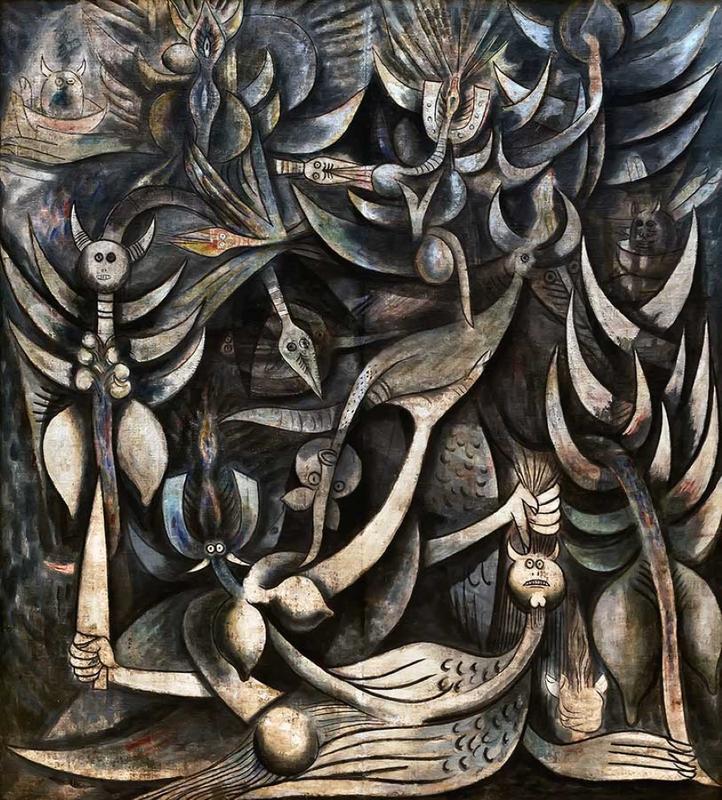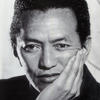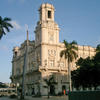More about Hurricane

Sr. Contributor
During his lifetime, Wifredo Lam traveled far and wide, but he ultimately made some of his best work back home in Cuba.
Hurricane is a perfect example of how Lam collected inspiration and lessons from his travels and applied them to his experience back in Cuba. As a student on scholarship, he studied the works of Paul Gauguin, the German Expressionists, and Henri Matisse, who all taught Lam to simplify the forms that he used in his paintings and move in the direction of European modernism. But for Lam, everything was a learning experience, so he continued to integrate the styles and techniques of his foreign teachers even after his formal studies ended.
This was especially true when Lam moved to Paris in 1938, where Pablo Picasso introduced him to the geometrical aspects of cubism, influenced himself by the stylized nature of African art and masks. While the lasting influence of Picasso’s artistic approach remains evident in Lam’s work, Lam’s first encounter with the famous Spaniard wasn't great. Because of Lam’s dark complexion, Picasso assumed that he had African ancestry and, thus, associated Lam with a sense of authenticity and primitivism that he had connected with African art. Not a great look. However, this meeting wasn’t as cringe-worthy as it sounds. Picasso had a lasting influence, and Lam continued to incorporate Afro-Cuban elements in his body of work.
However, Lam maintained a different approach to the art of Africa and Oceania than Picasso. While Picasso merely admired what he had deemed “primitive,” Lam - who was of African, Chinese, and European descent - shared both his ancestry and identity with the peoples who created these works. Lam also had the benefit of meeting and working with other artists, which allowed him to distill Picasso’s teachings and utilize them in a unique way that made sense to him. However, Lam had to cut his time in Europe short, leaving in 1941 to escape German occupation. Lam continued to travel and sought out other artists to meet along the way. When Lam traveled to Mexico, he stayed at the home of Frida Kahlo and Diego Rivera, who encouraged Lam to explore Surrealism.
Upon returning to Cuba, Lam found that things had not gotten much better in the eighteen years that he had been away. Inequity and corruption still reigned in his native country. Realizing the need for their representation on a global scale, Lam was moved to represent the Afro-Cuban traditions of his country. In his native Cuba, Lam embarked on a journey of self-discovery, eventually finding his signature style that we see in this painting.
Hurricane is evidence of Lam’s travels abroad, as well as his experiences with and admiration for Cuban culture. For Lam, the physical and spiritual worlds collide in ways that create an aesthetically interesting and ideologically captivating composition that could not exist without the cultural intersections of Wifredo Lam’s life experience.
Sources
- Museo Nacional de Bellas Artes de Cuba. “Wifredo Lam, Huracan, 1945.” Collection. https://www.bellasartes.co.cu/obra/wifredo-lam-huracan-1945. Accessed 13 September 2021.
- Museum of Modern Art. “Wifredo Lam. The Jungle.” MoMA Learning. https://www.moma.org/learn/moma_learning/wifredo-lam-the-jungle-1943/. Accessed 13 September 2021.
- Solomon R. Guggenheim Foundation. “Wifredo Lam.” Artists. Collection Online, https://www.guggenheim.org/artwork/artist/wifredo-lam. Accessed 16 August 2021.
- Solomon R. Guggenheim Foundation. “Zambezia, Zamebzia.” Collection Online. https://www.guggenheim.org/artwork/2403. Accessed 17 August 2021.
- Tate. ”Who is Wifredo Lam?” Exhibitions. Tate Modern. https://www.tate.org.uk/whats-on/tate-modern/exhibition/ey-exhibition-w… 13 September 2021.
- The Centre Pompidou. “Wifredo Lam Boutique du Centre Pompidou.” Exhibitions. https://boutique.centrepompidou.fr/en/evenement/g341/wifredo-lam/1/. Accessed 16 August 2021.











